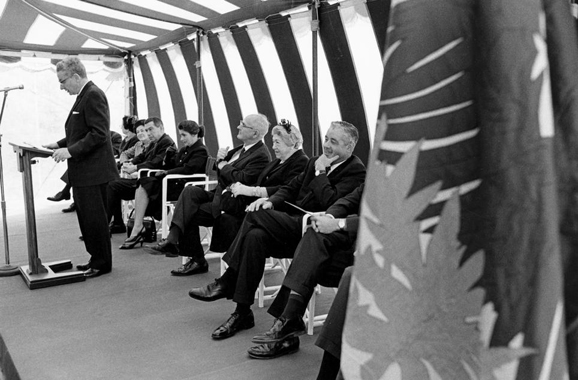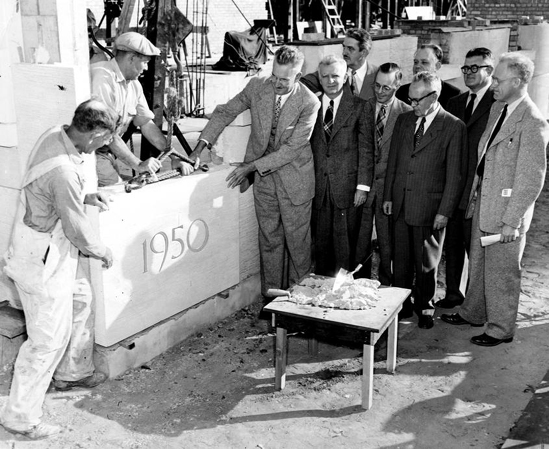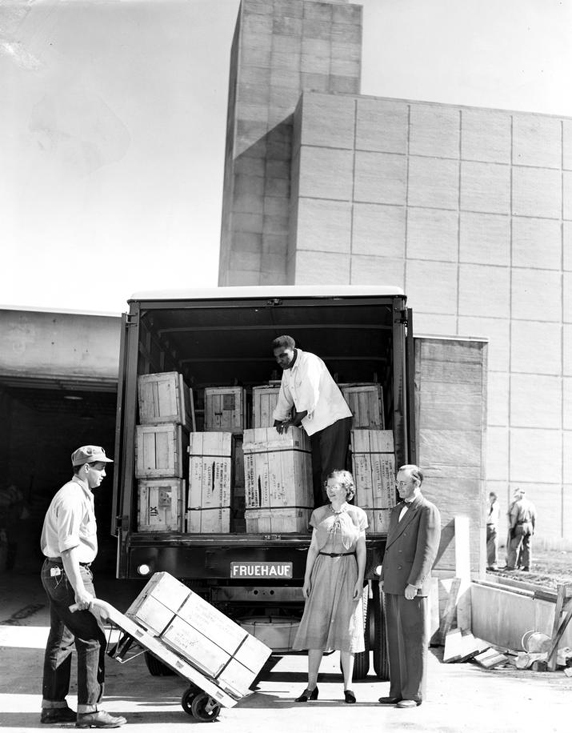The Pioneers
Herman H. Fussler (1915–1997) and the creation of the Center for Research Libraries
Edward J. Valauskas
Herman H. Fussler, director of the University of Chicago libraries for over three decades, was instrumental in the development and birth of the Midwest Inter–Library Center, renamed the Center for Research Libraries in 1965.

Figure 1: Herman Fussler speaking at the groundbreaking ceremonies for the University of Chicago’s Regenstein Library in 1970. Seated from center to right: George W. Beadle, Helen Regenstein, and Gaylord Donnelley.
Source: Archival Photofiles, apf2–06207, Special Collections Research Center, University of Chicago Library.
Fussler recognized that academic libraries were facing enormous problems as their collections grew. He was not the first, of course, to recognize this issue [1]. He however was quick to act to resolve a problem that soon would face the University of Chicago Library and other large academic libraries in the Midwest.
As early as 1940, a group of Midwest university presidents and librarians recognized the growing space dilemma in their libraries and discussed the notion of a centralized storage space for infrequently used printed matter [2].
Fussler succinctly understood the issue at hand and expressed it in several documents in 1947. In his Proposal for a Study of Middle Western Library Cooperation, written with E.W. McDiarmid (Librarian at the University of Minnesota), the nature of the problem was described in this way [3]:
“Inasmuch as it is apparent that no library can expand indefinitely without collapsing from its own weight, and that scholars’ interests cannot be limited in subject or time span, except in the most limited manner, some alternative solutions for actual space that will not involve serious obstacles to scholarship and research are essential.”
In Fussler’s A Preliminary Memorandum on Certain Aspects of the Cooperative Storage and Use of Books, he elaborated on the enormity of the issue [4]:
“It is yet to generally be recognized that, no matter how great its resources, no library, nor any other organization, can expand indefinitely. There is a point at which further expansion becomes undesirable in (a) the expense and difficulties of maintenance and administration, (b) the efficiency of use for many users, (c) the space required, etc. The point at which this occurs has not been determined, and it is unlikely that will be found precisely for some time to come. ... It should be pointed out that, in general, the cost of unit processes in libraries increase in some proportion to the size of the library. That is, the larger the library the more it costs to buy a book, to catalogue it, probably event to store it, and certainly to use it.
Finally, it is a characteristic of larger libraries, especially those intended for research, to meet their functions by having available the vast bulk of their collections for the occasional user. Stated another way, it may be said that only a relatively small part of the large research collection is in active use at any one time, but the library’s effectiveness as a research library rests, not so much in this active percentage, as in the ability of the library to produce the special, little–used reference for which there is no substitute. ... That is the principal distinguishing feature of the research collection.
To permit good and effective research, the little–used material must (a) be available to the man who needs it, (b) he must be able to ascertain that it is, in fact, available, and (c) it must be available to him in a useful form and within a reasonable length of time. ...
A further evident characteristic of research is ... that any scrap of information may be essential at some point in time to some men doing serious work. Therefore the library operates knowing always that it can meet only a proportion of the needs of its clientele with its own resources. The pace of learning, the instability of research patterns in the modern world, the growth of research and other producers of information, all contribute towards making this proportion, for most institutions, a constantly diminishing one. ... more and more money is being spent to produce less and less satisfaction for a library’s clientele.”

Figure 2: The cornerstone is laid at the Midwest Inter–Library Center in 1950.
Source: Archival Photofiles, apf2–05179, Special Collections Research Center, University of Chicago Library.
Fussler in Preliminary Memorandum defined the solution simply as [5]:
“It is to be a library of ‘little–used books,’ not an active collection. It is a ‘libraries’ library’ and thus may not need to retain everything. ... [It is] neither a warehouse of books, nor a real cooperative library. It appears to be something in between ... tending more towards a warehouse with some appendages of a library ... .”
The Midwest Inter–Library Center was formed in 1949 essentially along the lines of Fussler’s vision of a “libraries’ library” and formally opened in 1951 near the University of Chicago campus [6].
The success of the Midwest Inter–Library Center came quickly in its history. This hybrid of both a library and a consortium, as envisioned by Fussler and others, made its impression in a variety of ways. Fussler synthesized this success in a letter to Ralph T. Esterquest, then director of the Midwest Inter–Library Center, in 1953 [7]:
“... scholarship requires access to the recorded knowledge of mankind; that the bulk of recorded knowledge and information is expanding with no terminus in sight; and that no institution has or will have the resources in money, space, or staff to acquire and house the material to which its scholars are likely to require access. In the light of this situation one of the inevitable steps is to explore cooperative access to materials ... . For cooperative access to be successful there are certain essential conditions which must be met. These appear to require access must be assured, convenient, and fast. These conditions the Midwest Inter–Library Center is uniquely able to meet with respect to certain infrequently used research materials. The institutions have no better prospect of adding to this kind of essential resource at so little cost.”

Figure 3: The first shipment arrives at the Midwest Inter–Library Center. Daniel Simons (with cart) and Robert Hurt (on truck), Midwest Inter–Library Center staff, unload a box of Nuremberg war crime trials documents, a deposit from the Northwestern University Library. Acquisitions Librarian Helen Schmidt and Ralph T. Esterquest, the Center’s director, stand to the right.
Source: Archival Photofiles, apf2–05181, Special Collections Research Center, University of Chicago Library.
For a researcher in Iowa, the Center provided access at nearly the “speed of light” [8]:
“A botany professor on a Friday morning called the University of Iowa library, requesting a dissertation published in Germany in 1936. At 10:20 the library teletyped the request to the Midwest Center in Chicago. Within a quarter of an hour word came back that the dissertation was available. It was placed on a train leaving Chicago in the early afternoon and was delivered to the professor at 8 A.M. the following morning, less than 24 hours after he made his request.”
For this researcher, Fussler’s vision of a new kind of library made research a different kind of experience — timely, convenient, and practical. For librarians, the Midwest Inter–Library Center became a model for cooperation, a true library of the future.
 Acknowledgements
Acknowledgements
I thank Alice Schreyer, Director of the Special Collections Research Center at the University of Chicago Libraries, and her staff for providing access to records of the University Library related to the Midwest Inter–Library Center from the period 1940–1955.
 Notes
Notes
1. See, for example, Anonymous, 2007. “Remote Storage in Research Libraries, a Microhistory,” at http://www.library.cornell.edu/colldev/storagehistory.html; and, Gordon R. Williams, 1971. “Physical Access to Library Materials,” PMLA, volume 86, number 4 (September), pp. 590–593; originally appeared in the ACLS Newsletter, volume 22 (January), pp. 14–19.
2. Minutes of the Conference of Representatives of Thirteen Mid–Western Universities on Cooperation, Coordination and Regionalization in Education, Chicago (10 February 1940): “It was indicated that it might be possible to establish a central storage library where infrequently used books might be deposited.” These Minutes are in the records of the University Library, Special Collections Research Center, University of Chicago.
3. E.W. McDiarmid and Herman H. Fussler, Proposal for a Study of Middle Western Library Cooperation (16 June 1947), records of the University Library, Special Collections Research Center, University of Chicago.
4. Emphasis in the original. See Herman H. Fussler, A Preliminary Memorandum on Certain Aspects of the Cooperative Storage and Use of Books (13 June 1947), pp. 1–2; in the records of the University Library, Special Collections Research Center, University of Chicago.
5. Fussler, Preliminary Memorandum (13 June 1947), p. 5.
6. Ralph T. Esterquest, “The Midwest Inter–Library Center,” Journal of Higher Education, volume 24, number 1 (January 1953), pp. 2–3.
7. Emphasis mine; letter dated 26 May 1953 to Ralph T. Esterquest, Director, Midwest Inter–Library Center, from Herman H. Fussler; in the records of the University Library, Special Collections Research Center, University of Chicago.
8. Anonymous, “Almost the Speed of Light,” Midwest Inter–Library Center Newsletter, number 38 (28 February 1953), p. 9.
About the Author
Edward J. Valauskas is the Follett Chair in the Graduate School of Library and Information Science at Dominican University in River Forest, Ill.
E–mail: ejv [at] dom [dot] edu
© 2007 Edward J. Valauskas
Top of Page | Table of Contents


